Professional Development Report: Strategic Skills for Tesco Managers
VerifiedAdded on 2020/01/23
|22
|6548
|262
Report
AI Summary
This report assesses the personal and professional skills required for strategic managers, focusing on a manager at Tesco. It evaluates time management, problem-solving, and communication skills using checklists, psychometric tests, and 360-degree analysis. The report also examines the application of professional skills such as coaching, mentoring, and leadership. It includes a skills audit to identify areas for improvement and a personal development plan designed to address shortcomings and meet future professional requirements. The report aims to determine strengths, weaknesses, and opportunities for professional growth within the context of Tesco's strategic goals, and to contribute to the enhancement of managerial effectiveness and organizational success. The report also includes tables and figures to illustrate the evaluation methods and findings, providing a comprehensive overview of the skills assessment and development process.
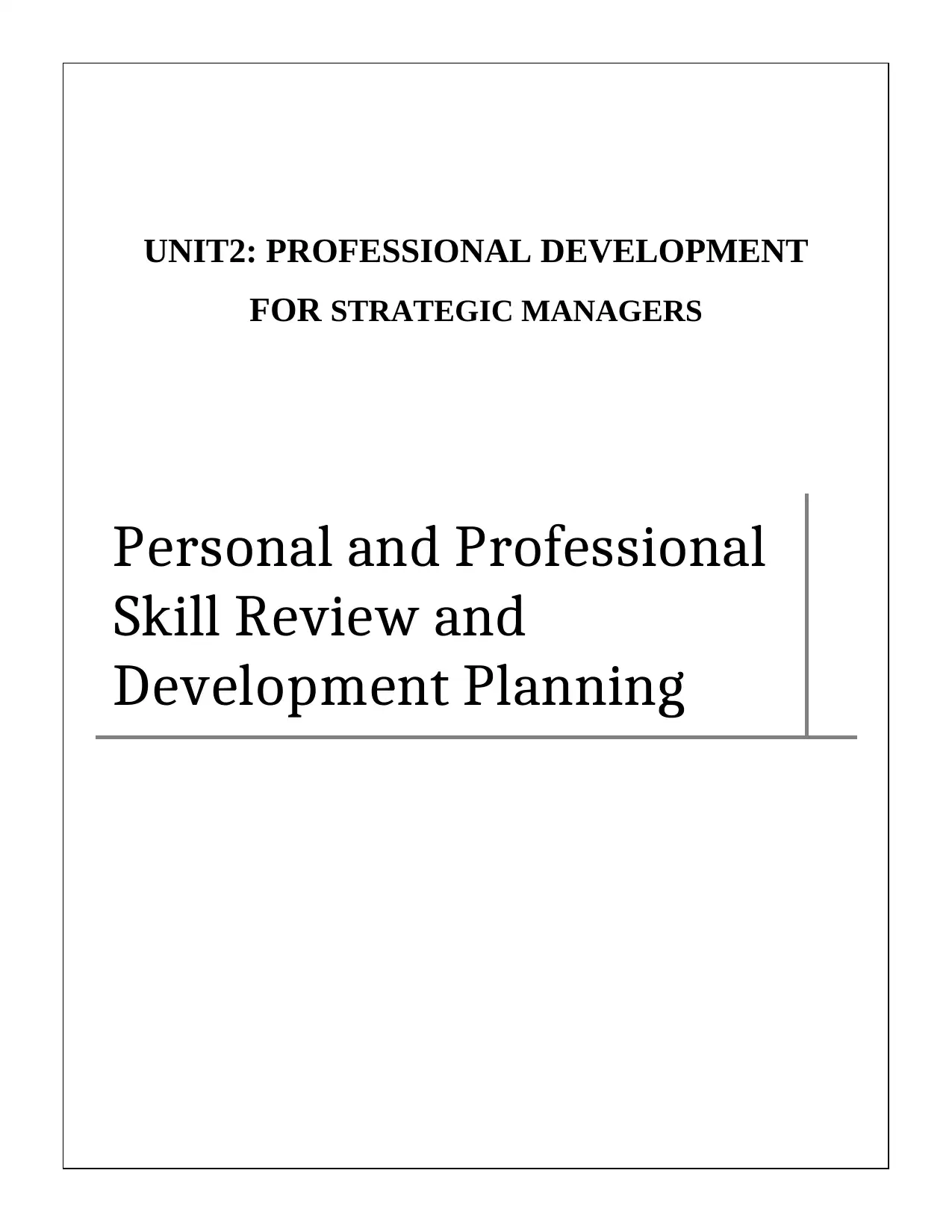
UNIT2: PROFESSIONAL DEVELOPMENT
FOR STRATEGIC MANAGERS
Personal and Professional
Skill Review and
Development Planning
FOR STRATEGIC MANAGERS
Personal and Professional
Skill Review and
Development Planning
Paraphrase This Document
Need a fresh take? Get an instant paraphrase of this document with our AI Paraphraser
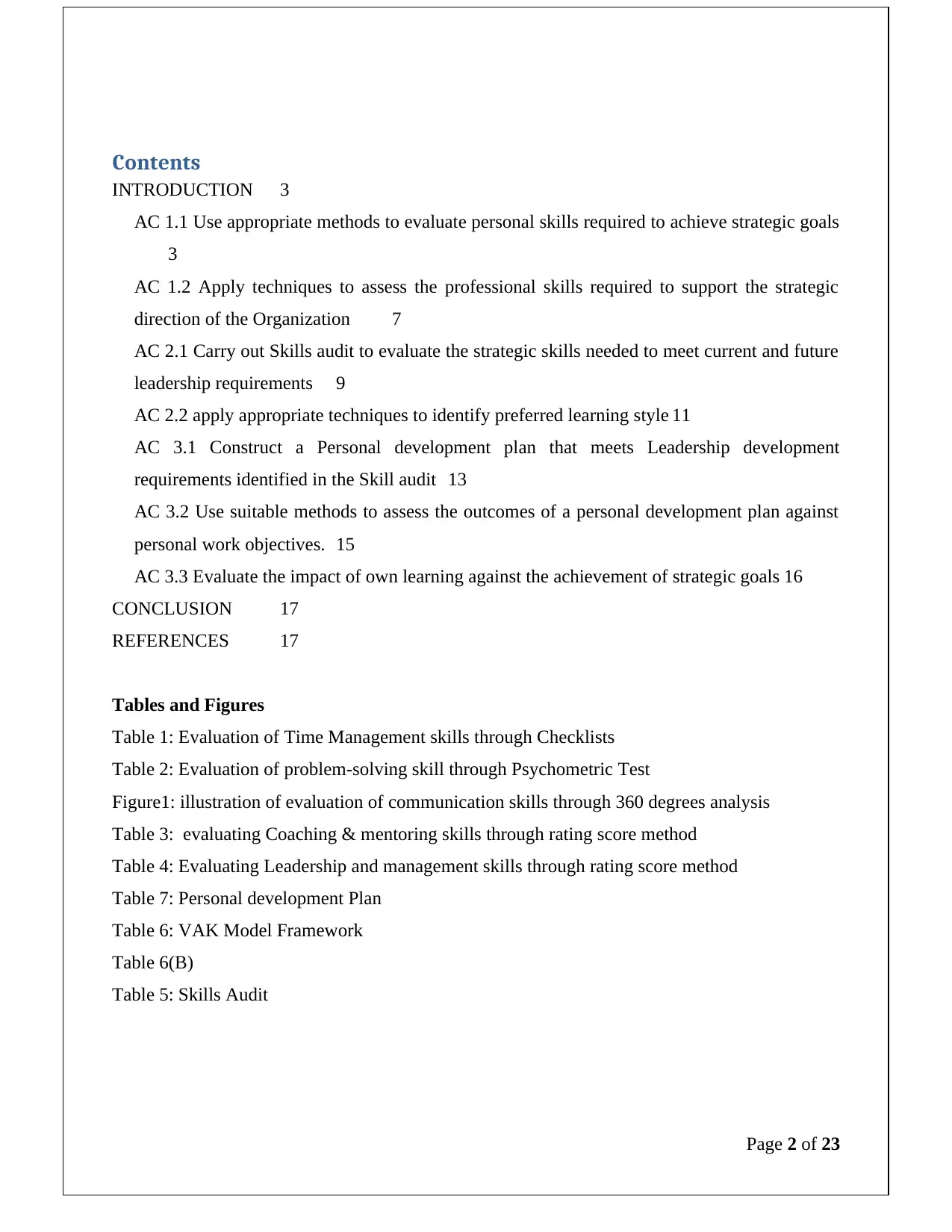
Contents
INTRODUCTION 3
AC 1.1 Use appropriate methods to evaluate personal skills required to achieve strategic goals
3
AC 1.2 Apply techniques to assess the professional skills required to support the strategic
direction of the Organization 7
AC 2.1 Carry out Skills audit to evaluate the strategic skills needed to meet current and future
leadership requirements 9
AC 2.2 apply appropriate techniques to identify preferred learning style 11
AC 3.1 Construct a Personal development plan that meets Leadership development
requirements identified in the Skill audit 13
AC 3.2 Use suitable methods to assess the outcomes of a personal development plan against
personal work objectives. 15
AC 3.3 Evaluate the impact of own learning against the achievement of strategic goals 16
CONCLUSION 17
REFERENCES 17
Tables and Figures
Table 1: Evaluation of Time Management skills through Checklists
Table 2: Evaluation of problem-solving skill through Psychometric Test
Figure1: illustration of evaluation of communication skills through 360 degrees analysis
Table 3: evaluating Coaching & mentoring skills through rating score method
Table 4: Evaluating Leadership and management skills through rating score method
Table 7: Personal development Plan
Table 6: VAK Model Framework
Table 6(B)
Table 5: Skills Audit
Page 2 of 23
INTRODUCTION 3
AC 1.1 Use appropriate methods to evaluate personal skills required to achieve strategic goals
3
AC 1.2 Apply techniques to assess the professional skills required to support the strategic
direction of the Organization 7
AC 2.1 Carry out Skills audit to evaluate the strategic skills needed to meet current and future
leadership requirements 9
AC 2.2 apply appropriate techniques to identify preferred learning style 11
AC 3.1 Construct a Personal development plan that meets Leadership development
requirements identified in the Skill audit 13
AC 3.2 Use suitable methods to assess the outcomes of a personal development plan against
personal work objectives. 15
AC 3.3 Evaluate the impact of own learning against the achievement of strategic goals 16
CONCLUSION 17
REFERENCES 17
Tables and Figures
Table 1: Evaluation of Time Management skills through Checklists
Table 2: Evaluation of problem-solving skill through Psychometric Test
Figure1: illustration of evaluation of communication skills through 360 degrees analysis
Table 3: evaluating Coaching & mentoring skills through rating score method
Table 4: Evaluating Leadership and management skills through rating score method
Table 7: Personal development Plan
Table 6: VAK Model Framework
Table 6(B)
Table 5: Skills Audit
Page 2 of 23
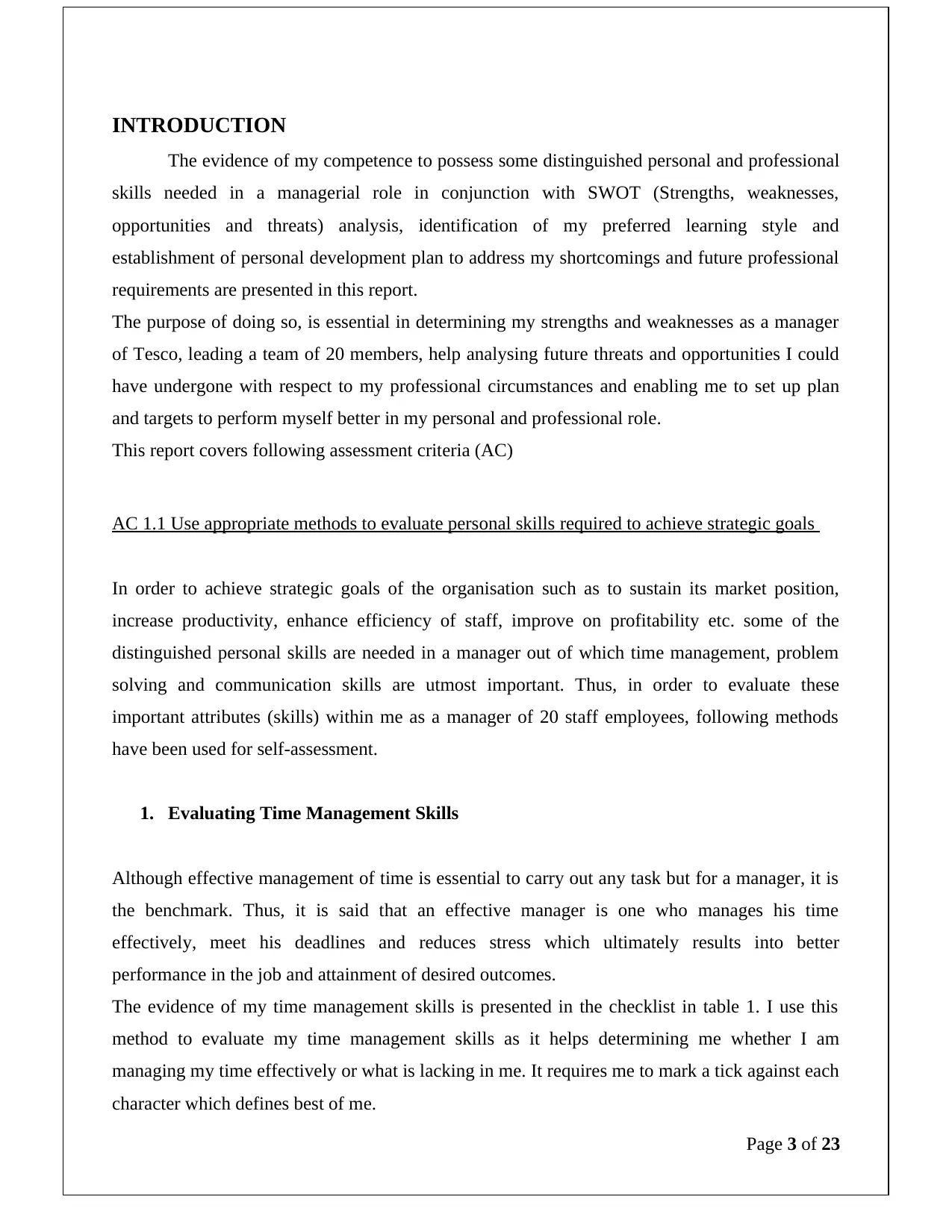
INTRODUCTION
The evidence of my competence to possess some distinguished personal and professional
skills needed in a managerial role in conjunction with SWOT (Strengths, weaknesses,
opportunities and threats) analysis, identification of my preferred learning style and
establishment of personal development plan to address my shortcomings and future professional
requirements are presented in this report.
The purpose of doing so, is essential in determining my strengths and weaknesses as a manager
of Tesco, leading a team of 20 members, help analysing future threats and opportunities I could
have undergone with respect to my professional circumstances and enabling me to set up plan
and targets to perform myself better in my personal and professional role.
This report covers following assessment criteria (AC)
AC 1.1 Use appropriate methods to evaluate personal skills required to achieve strategic goals
In order to achieve strategic goals of the organisation such as to sustain its market position,
increase productivity, enhance efficiency of staff, improve on profitability etc. some of the
distinguished personal skills are needed in a manager out of which time management, problem
solving and communication skills are utmost important. Thus, in order to evaluate these
important attributes (skills) within me as a manager of 20 staff employees, following methods
have been used for self-assessment.
1. Evaluating Time Management Skills
Although effective management of time is essential to carry out any task but for a manager, it is
the benchmark. Thus, it is said that an effective manager is one who manages his time
effectively, meet his deadlines and reduces stress which ultimately results into better
performance in the job and attainment of desired outcomes.
The evidence of my time management skills is presented in the checklist in table 1. I use this
method to evaluate my time management skills as it helps determining me whether I am
managing my time effectively or what is lacking in me. It requires me to mark a tick against each
character which defines best of me.
Page 3 of 23
The evidence of my competence to possess some distinguished personal and professional
skills needed in a managerial role in conjunction with SWOT (Strengths, weaknesses,
opportunities and threats) analysis, identification of my preferred learning style and
establishment of personal development plan to address my shortcomings and future professional
requirements are presented in this report.
The purpose of doing so, is essential in determining my strengths and weaknesses as a manager
of Tesco, leading a team of 20 members, help analysing future threats and opportunities I could
have undergone with respect to my professional circumstances and enabling me to set up plan
and targets to perform myself better in my personal and professional role.
This report covers following assessment criteria (AC)
AC 1.1 Use appropriate methods to evaluate personal skills required to achieve strategic goals
In order to achieve strategic goals of the organisation such as to sustain its market position,
increase productivity, enhance efficiency of staff, improve on profitability etc. some of the
distinguished personal skills are needed in a manager out of which time management, problem
solving and communication skills are utmost important. Thus, in order to evaluate these
important attributes (skills) within me as a manager of 20 staff employees, following methods
have been used for self-assessment.
1. Evaluating Time Management Skills
Although effective management of time is essential to carry out any task but for a manager, it is
the benchmark. Thus, it is said that an effective manager is one who manages his time
effectively, meet his deadlines and reduces stress which ultimately results into better
performance in the job and attainment of desired outcomes.
The evidence of my time management skills is presented in the checklist in table 1. I use this
method to evaluate my time management skills as it helps determining me whether I am
managing my time effectively or what is lacking in me. It requires me to mark a tick against each
character which defines best of me.
Page 3 of 23
⊘ This is a preview!⊘
Do you want full access?
Subscribe today to unlock all pages.

Trusted by 1+ million students worldwide
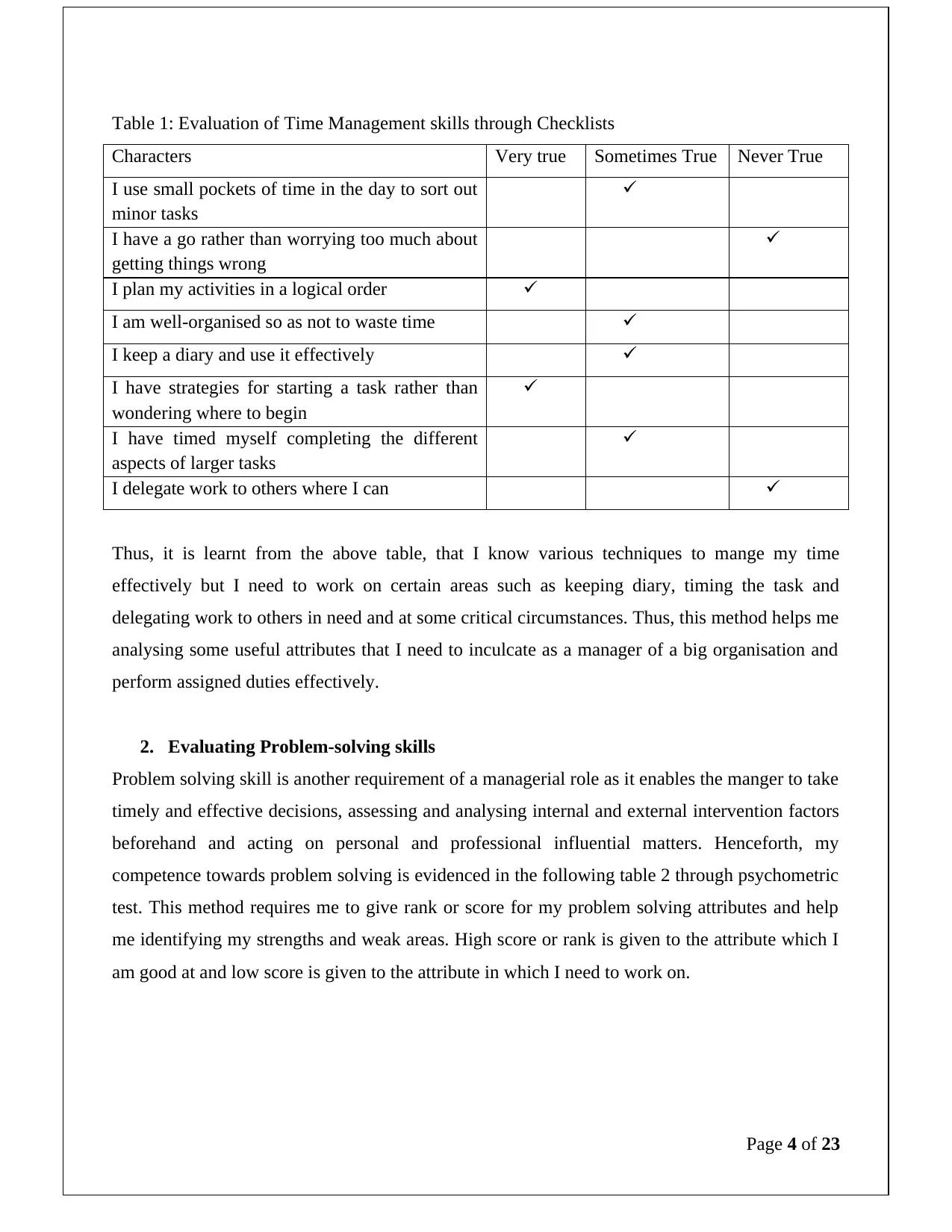
Table 1: Evaluation of Time Management skills through Checklists
Characters Very true Sometimes True Never True
I use small pockets of time in the day to sort out
minor tasks
I have a go rather than worrying too much about
getting things wrong
I plan my activities in a logical order
I am well-organised so as not to waste time
I keep a diary and use it effectively
I have strategies for starting a task rather than
wondering where to begin
I have timed myself completing the different
aspects of larger tasks
I delegate work to others where I can
Thus, it is learnt from the above table, that I know various techniques to mange my time
effectively but I need to work on certain areas such as keeping diary, timing the task and
delegating work to others in need and at some critical circumstances. Thus, this method helps me
analysing some useful attributes that I need to inculcate as a manager of a big organisation and
perform assigned duties effectively.
2. Evaluating Problem-solving skills
Problem solving skill is another requirement of a managerial role as it enables the manger to take
timely and effective decisions, assessing and analysing internal and external intervention factors
beforehand and acting on personal and professional influential matters. Henceforth, my
competence towards problem solving is evidenced in the following table 2 through psychometric
test. This method requires me to give rank or score for my problem solving attributes and help
me identifying my strengths and weak areas. High score or rank is given to the attribute which I
am good at and low score is given to the attribute in which I need to work on.
Page 4 of 23
Characters Very true Sometimes True Never True
I use small pockets of time in the day to sort out
minor tasks
I have a go rather than worrying too much about
getting things wrong
I plan my activities in a logical order
I am well-organised so as not to waste time
I keep a diary and use it effectively
I have strategies for starting a task rather than
wondering where to begin
I have timed myself completing the different
aspects of larger tasks
I delegate work to others where I can
Thus, it is learnt from the above table, that I know various techniques to mange my time
effectively but I need to work on certain areas such as keeping diary, timing the task and
delegating work to others in need and at some critical circumstances. Thus, this method helps me
analysing some useful attributes that I need to inculcate as a manager of a big organisation and
perform assigned duties effectively.
2. Evaluating Problem-solving skills
Problem solving skill is another requirement of a managerial role as it enables the manger to take
timely and effective decisions, assessing and analysing internal and external intervention factors
beforehand and acting on personal and professional influential matters. Henceforth, my
competence towards problem solving is evidenced in the following table 2 through psychometric
test. This method requires me to give rank or score for my problem solving attributes and help
me identifying my strengths and weak areas. High score or rank is given to the attribute which I
am good at and low score is given to the attribute in which I need to work on.
Page 4 of 23
Paraphrase This Document
Need a fresh take? Get an instant paraphrase of this document with our AI Paraphraser
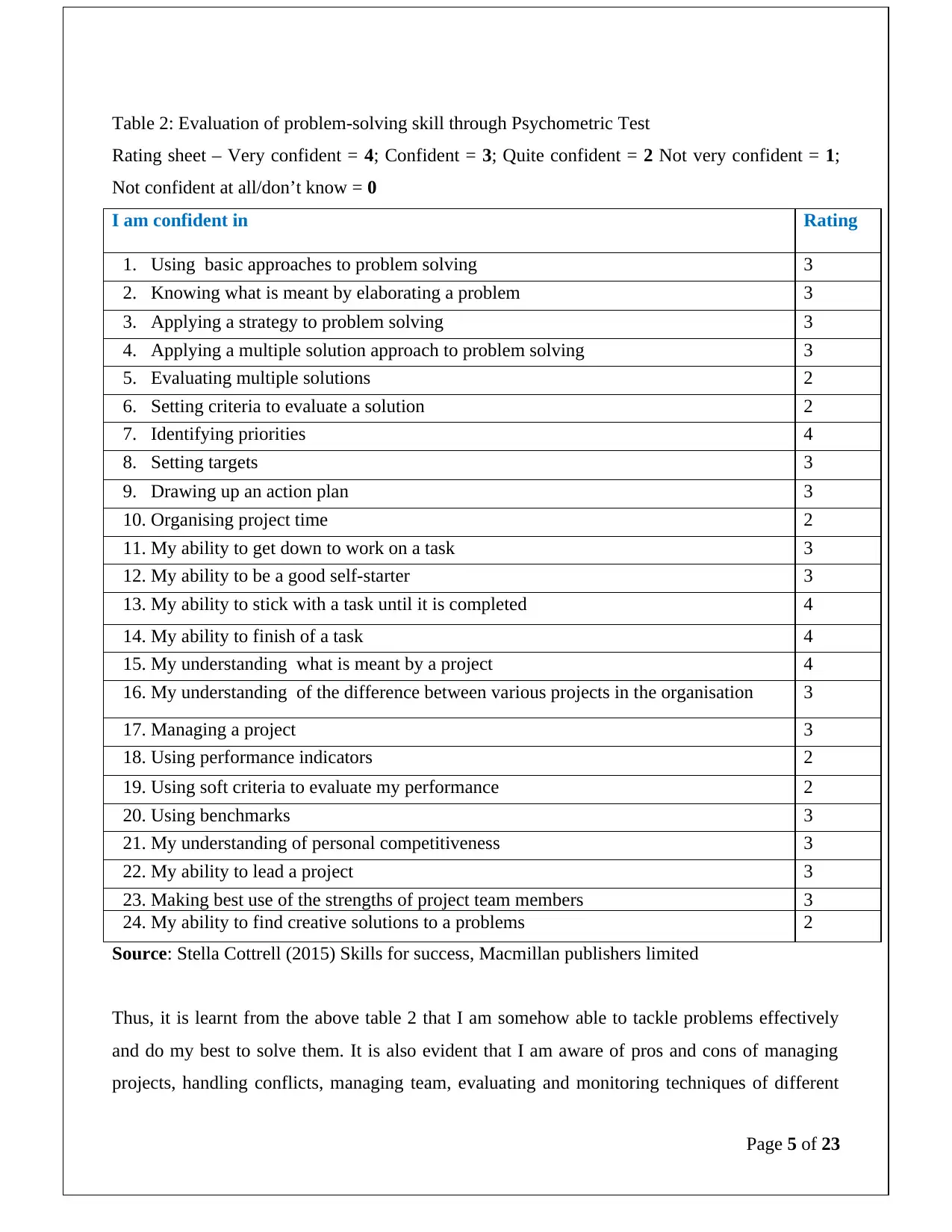
Table 2: Evaluation of problem-solving skill through Psychometric Test
Rating sheet – Very confident = 4; Confident = 3; Quite confident = 2 Not very confident = 1;
Not confident at all/don’t know = 0
I am confident in Rating
1. Using basic approaches to problem solving 3
2. Knowing what is meant by elaborating a problem 3
3. Applying a strategy to problem solving 3
4. Applying a multiple solution approach to problem solving 3
5. Evaluating multiple solutions 2
6. Setting criteria to evaluate a solution 2
7. Identifying priorities 4
8. Setting targets 3
9. Drawing up an action plan 3
10. Organising project time 2
11. My ability to get down to work on a task 3
12. My ability to be a good self-starter 3
13. My ability to stick with a task until it is completed 4
14. My ability to finish of a task 4
15. My understanding what is meant by a project 4
16. My understanding of the difference between various projects in the organisation 3
17. Managing a project 3
18. Using performance indicators 2
19. Using soft criteria to evaluate my performance 2
20. Using benchmarks 3
21. My understanding of personal competitiveness 3
22. My ability to lead a project 3
23. Making best use of the strengths of project team members 3
24. My ability to find creative solutions to a problems 2
Source: Stella Cottrell (2015) Skills for success, Macmillan publishers limited
Thus, it is learnt from the above table 2 that I am somehow able to tackle problems effectively
and do my best to solve them. It is also evident that I am aware of pros and cons of managing
projects, handling conflicts, managing team, evaluating and monitoring techniques of different
Page 5 of 23
Rating sheet – Very confident = 4; Confident = 3; Quite confident = 2 Not very confident = 1;
Not confident at all/don’t know = 0
I am confident in Rating
1. Using basic approaches to problem solving 3
2. Knowing what is meant by elaborating a problem 3
3. Applying a strategy to problem solving 3
4. Applying a multiple solution approach to problem solving 3
5. Evaluating multiple solutions 2
6. Setting criteria to evaluate a solution 2
7. Identifying priorities 4
8. Setting targets 3
9. Drawing up an action plan 3
10. Organising project time 2
11. My ability to get down to work on a task 3
12. My ability to be a good self-starter 3
13. My ability to stick with a task until it is completed 4
14. My ability to finish of a task 4
15. My understanding what is meant by a project 4
16. My understanding of the difference between various projects in the organisation 3
17. Managing a project 3
18. Using performance indicators 2
19. Using soft criteria to evaluate my performance 2
20. Using benchmarks 3
21. My understanding of personal competitiveness 3
22. My ability to lead a project 3
23. Making best use of the strengths of project team members 3
24. My ability to find creative solutions to a problems 2
Source: Stella Cottrell (2015) Skills for success, Macmillan publishers limited
Thus, it is learnt from the above table 2 that I am somehow able to tackle problems effectively
and do my best to solve them. It is also evident that I am aware of pros and cons of managing
projects, handling conflicts, managing team, evaluating and monitoring techniques of different
Page 5 of 23
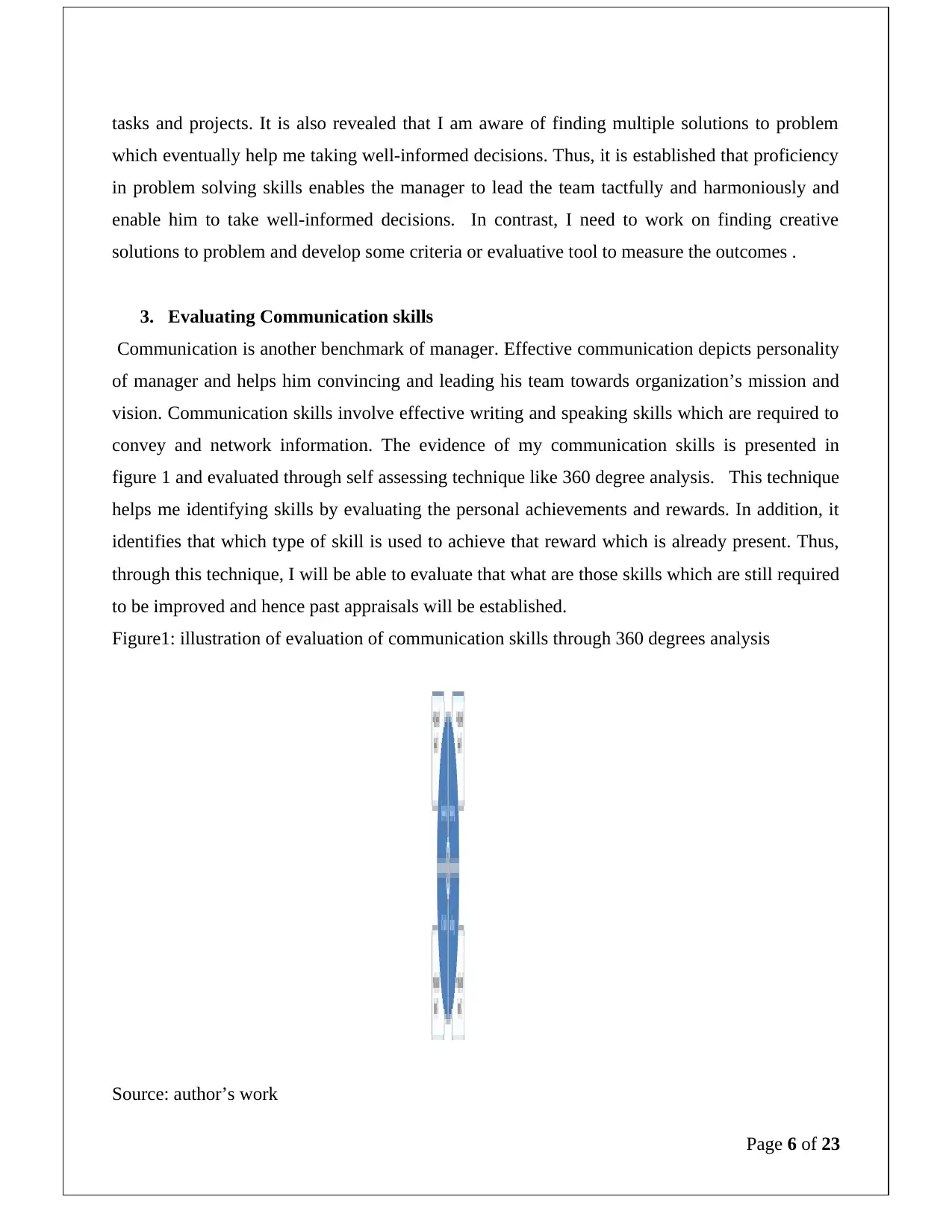
tasks and projects. It is also revealed that I am aware of finding multiple solutions to problem
which eventually help me taking well-informed decisions. Thus, it is established that proficiency
in problem solving skills enables the manager to lead the team tactfully and harmoniously and
enable him to take well-informed decisions. In contrast, I need to work on finding creative
solutions to problem and develop some criteria or evaluative tool to measure the outcomes .
3. Evaluating Communication skills
Communication is another benchmark of manager. Effective communication depicts personality
of manager and helps him convincing and leading his team towards organization’s mission and
vision. Communication skills involve effective writing and speaking skills which are required to
convey and network information. The evidence of my communication skills is presented in
figure 1 and evaluated through self assessing technique like 360 degree analysis. This technique
helps me identifying skills by evaluating the personal achievements and rewards. In addition, it
identifies that which type of skill is used to achieve that reward which is already present. Thus,
through this technique, I will be able to evaluate that what are those skills which are still required
to be improved and hence past appraisals will be established.
Figure1: illustration of evaluation of communication skills through 360 degrees analysis
Source: author’s work
Page 6 of 23
which eventually help me taking well-informed decisions. Thus, it is established that proficiency
in problem solving skills enables the manager to lead the team tactfully and harmoniously and
enable him to take well-informed decisions. In contrast, I need to work on finding creative
solutions to problem and develop some criteria or evaluative tool to measure the outcomes .
3. Evaluating Communication skills
Communication is another benchmark of manager. Effective communication depicts personality
of manager and helps him convincing and leading his team towards organization’s mission and
vision. Communication skills involve effective writing and speaking skills which are required to
convey and network information. The evidence of my communication skills is presented in
figure 1 and evaluated through self assessing technique like 360 degree analysis. This technique
helps me identifying skills by evaluating the personal achievements and rewards. In addition, it
identifies that which type of skill is used to achieve that reward which is already present. Thus,
through this technique, I will be able to evaluate that what are those skills which are still required
to be improved and hence past appraisals will be established.
Figure1: illustration of evaluation of communication skills through 360 degrees analysis
Source: author’s work
Page 6 of 23
⊘ This is a preview!⊘
Do you want full access?
Subscribe today to unlock all pages.

Trusted by 1+ million students worldwide
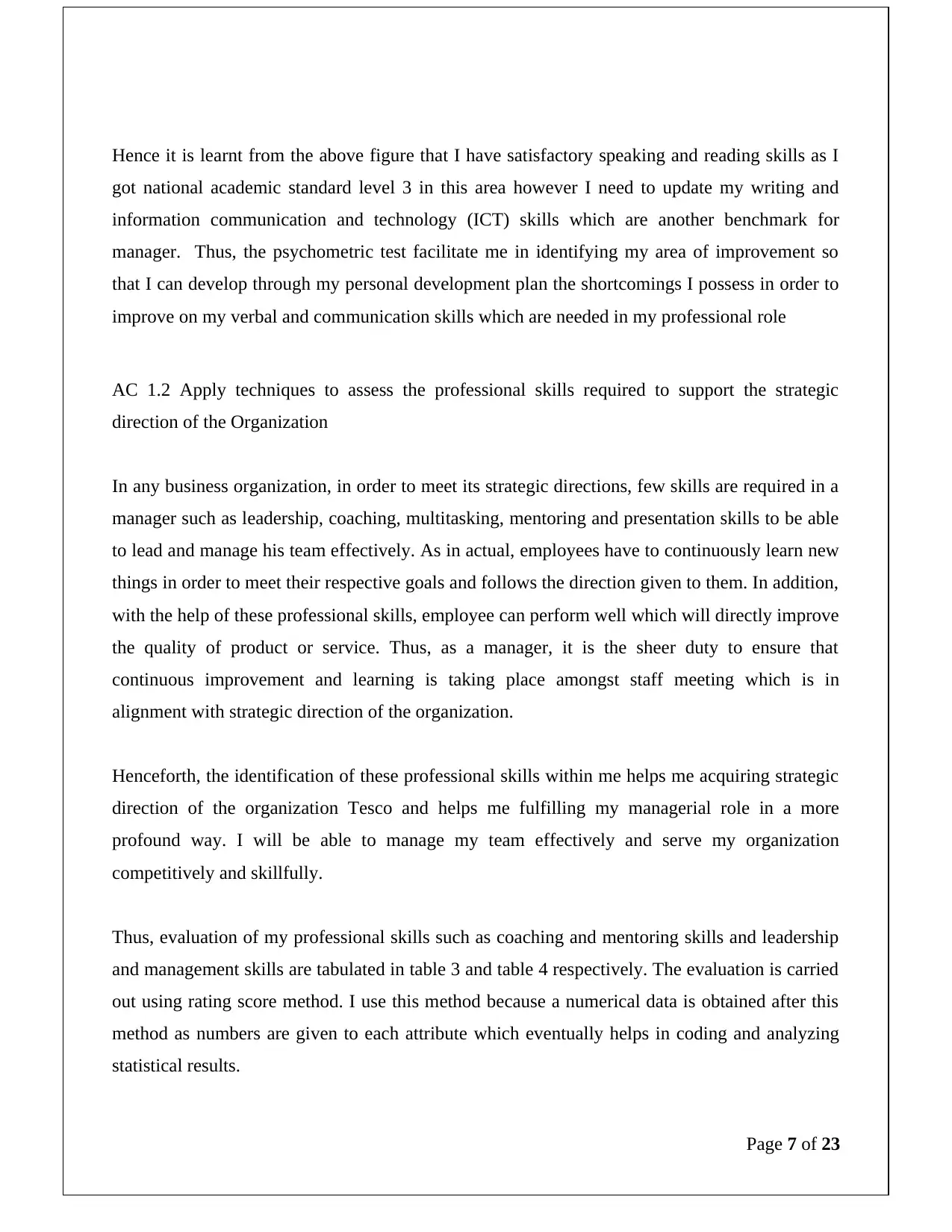
Hence it is learnt from the above figure that I have satisfactory speaking and reading skills as I
got national academic standard level 3 in this area however I need to update my writing and
information communication and technology (ICT) skills which are another benchmark for
manager. Thus, the psychometric test facilitate me in identifying my area of improvement so
that I can develop through my personal development plan the shortcomings I possess in order to
improve on my verbal and communication skills which are needed in my professional role
AC 1.2 Apply techniques to assess the professional skills required to support the strategic
direction of the Organization
In any business organization, in order to meet its strategic directions, few skills are required in a
manager such as leadership, coaching, multitasking, mentoring and presentation skills to be able
to lead and manage his team effectively. As in actual, employees have to continuously learn new
things in order to meet their respective goals and follows the direction given to them. In addition,
with the help of these professional skills, employee can perform well which will directly improve
the quality of product or service. Thus, as a manager, it is the sheer duty to ensure that
continuous improvement and learning is taking place amongst staff meeting which is in
alignment with strategic direction of the organization.
Henceforth, the identification of these professional skills within me helps me acquiring strategic
direction of the organization Tesco and helps me fulfilling my managerial role in a more
profound way. I will be able to manage my team effectively and serve my organization
competitively and skillfully.
Thus, evaluation of my professional skills such as coaching and mentoring skills and leadership
and management skills are tabulated in table 3 and table 4 respectively. The evaluation is carried
out using rating score method. I use this method because a numerical data is obtained after this
method as numbers are given to each attribute which eventually helps in coding and analyzing
statistical results.
Page 7 of 23
got national academic standard level 3 in this area however I need to update my writing and
information communication and technology (ICT) skills which are another benchmark for
manager. Thus, the psychometric test facilitate me in identifying my area of improvement so
that I can develop through my personal development plan the shortcomings I possess in order to
improve on my verbal and communication skills which are needed in my professional role
AC 1.2 Apply techniques to assess the professional skills required to support the strategic
direction of the Organization
In any business organization, in order to meet its strategic directions, few skills are required in a
manager such as leadership, coaching, multitasking, mentoring and presentation skills to be able
to lead and manage his team effectively. As in actual, employees have to continuously learn new
things in order to meet their respective goals and follows the direction given to them. In addition,
with the help of these professional skills, employee can perform well which will directly improve
the quality of product or service. Thus, as a manager, it is the sheer duty to ensure that
continuous improvement and learning is taking place amongst staff meeting which is in
alignment with strategic direction of the organization.
Henceforth, the identification of these professional skills within me helps me acquiring strategic
direction of the organization Tesco and helps me fulfilling my managerial role in a more
profound way. I will be able to manage my team effectively and serve my organization
competitively and skillfully.
Thus, evaluation of my professional skills such as coaching and mentoring skills and leadership
and management skills are tabulated in table 3 and table 4 respectively. The evaluation is carried
out using rating score method. I use this method because a numerical data is obtained after this
method as numbers are given to each attribute which eventually helps in coding and analyzing
statistical results.
Page 7 of 23
Paraphrase This Document
Need a fresh take? Get an instant paraphrase of this document with our AI Paraphraser

Table 3: evaluating Coaching & mentoring skills through rating score method
Very confident = 4; Confident = 3; Quite confident = 2 Not very confident = 1; Not confident at all/don’t know = 0
Consulting and Mentoring Skills Rating of
0-4
Personal style
1 I build rapport and establish trust 3
2 I maintain confidentiality 4
3 I am committed to the development of people 2
Giving feedback
4 I am forthright, constructive and challenging when giving feedback 3
4. I help people to gain new insight 3
7 I balance positive with negative 3
Questioning
8 I spend time questioning and probing others in order to understand problems fully 3
9 I use questions to help others review their progress. 3
10 I ask questions in order to understand people better, and what motivate them 3
Strategic Objectives and direction
12 I help others to set clear and achievable goal 3
13 I encourage others to work towards challenging professional and personal development goals 3
14 I set goals which ensure that people continue to develop new knowledge and skills 3
Being open and accessible
15 I make myself accessible to others 2
16 I make it easy for others to be open and candid 2
17 I make time to review performance and to support others 3
Active listening
18 I listen carefully and give full attention 3
20 I encourage others to talk and do not interrupt 3
21 I balance the amount of talking and listening 3
Flexibility
22 I am open to new idea 2
23 I stimulate people to use their creativity and explore different solutions 2
24 I help people to find their own solutions rather than telling people what to do 2
Source: Stella Cottrell (2015) Skills for success, Macmillan publishers limited
Thus, it is learnt from the above table that I posses satisfactory level of coaching and mentoring
skills and therefore is able to manage my team effectively and tactfully; although there are also
some significant areas which are ignored and needs to be addressed in order to enhance smooth
running of my team such as I need to build up useful skills of flexibility and to be open and
accessible which eventually helps me achieving success in my professional career.
Similarly, the evidence of my competence in leadership and management skills is tabulated in
table 4 using the same method.
Table 4: Evaluating Leadership and management skills through rating score method
I am confident in persuading and motivating my team in order to make things happen 3
I am supportive of my team members in times of need 3
I am good at delegate tasks to employees with appropriate skills set 2
Page 8 of 23
Very confident = 4; Confident = 3; Quite confident = 2 Not very confident = 1; Not confident at all/don’t know = 0
Consulting and Mentoring Skills Rating of
0-4
Personal style
1 I build rapport and establish trust 3
2 I maintain confidentiality 4
3 I am committed to the development of people 2
Giving feedback
4 I am forthright, constructive and challenging when giving feedback 3
4. I help people to gain new insight 3
7 I balance positive with negative 3
Questioning
8 I spend time questioning and probing others in order to understand problems fully 3
9 I use questions to help others review their progress. 3
10 I ask questions in order to understand people better, and what motivate them 3
Strategic Objectives and direction
12 I help others to set clear and achievable goal 3
13 I encourage others to work towards challenging professional and personal development goals 3
14 I set goals which ensure that people continue to develop new knowledge and skills 3
Being open and accessible
15 I make myself accessible to others 2
16 I make it easy for others to be open and candid 2
17 I make time to review performance and to support others 3
Active listening
18 I listen carefully and give full attention 3
20 I encourage others to talk and do not interrupt 3
21 I balance the amount of talking and listening 3
Flexibility
22 I am open to new idea 2
23 I stimulate people to use their creativity and explore different solutions 2
24 I help people to find their own solutions rather than telling people what to do 2
Source: Stella Cottrell (2015) Skills for success, Macmillan publishers limited
Thus, it is learnt from the above table that I posses satisfactory level of coaching and mentoring
skills and therefore is able to manage my team effectively and tactfully; although there are also
some significant areas which are ignored and needs to be addressed in order to enhance smooth
running of my team such as I need to build up useful skills of flexibility and to be open and
accessible which eventually helps me achieving success in my professional career.
Similarly, the evidence of my competence in leadership and management skills is tabulated in
table 4 using the same method.
Table 4: Evaluating Leadership and management skills through rating score method
I am confident in persuading and motivating my team in order to make things happen 3
I am supportive of my team members in times of need 3
I am good at delegate tasks to employees with appropriate skills set 2
Page 8 of 23
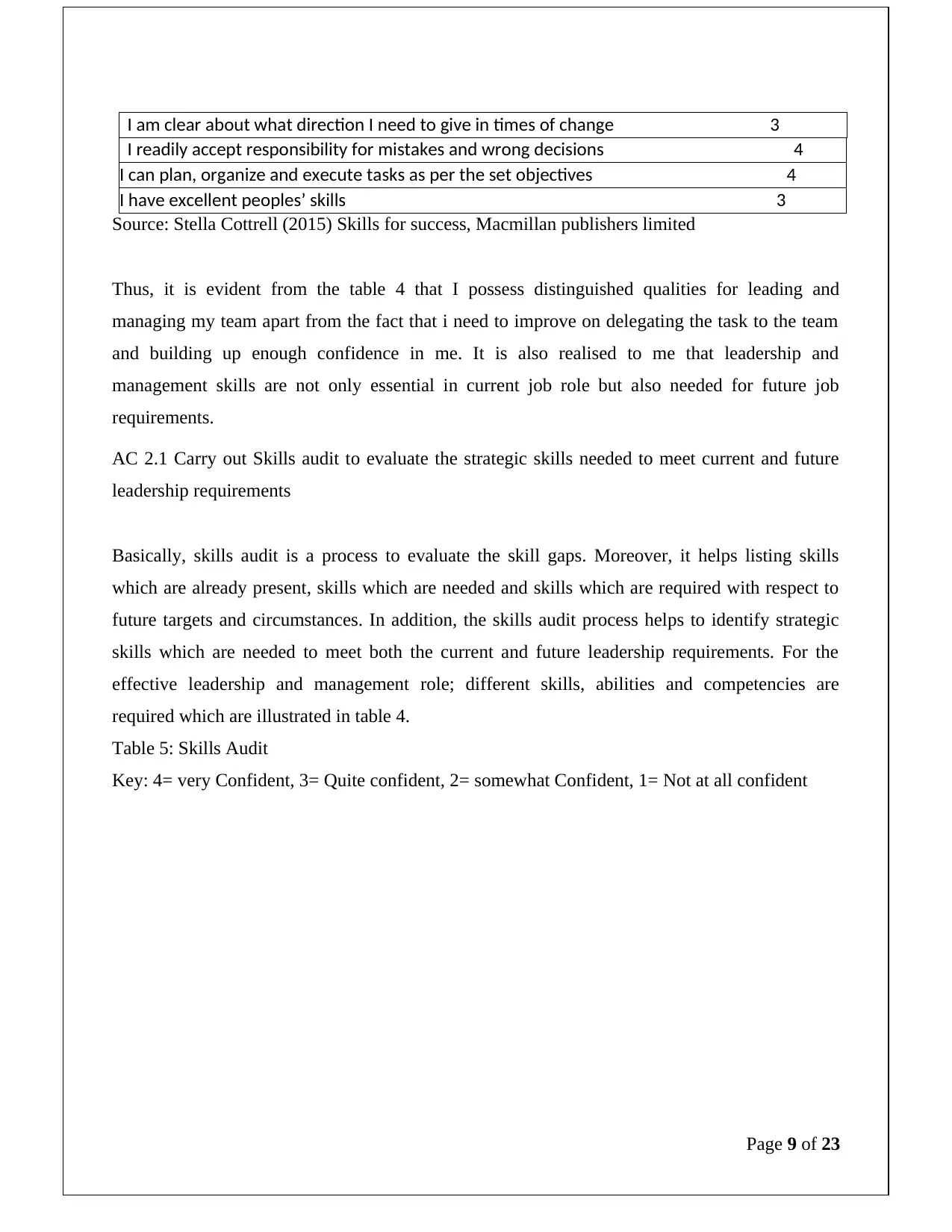
I am clear about what direction I need to give in times of change 3
I readily accept responsibility for mistakes and wrong decisions 4
I can plan, organize and execute tasks as per the set objectives 4
I have excellent peoples’ skills 3
Source: Stella Cottrell (2015) Skills for success, Macmillan publishers limited
Thus, it is evident from the table 4 that I possess distinguished qualities for leading and
managing my team apart from the fact that i need to improve on delegating the task to the team
and building up enough confidence in me. It is also realised to me that leadership and
management skills are not only essential in current job role but also needed for future job
requirements.
AC 2.1 Carry out Skills audit to evaluate the strategic skills needed to meet current and future
leadership requirements
Basically, skills audit is a process to evaluate the skill gaps. Moreover, it helps listing skills
which are already present, skills which are needed and skills which are required with respect to
future targets and circumstances. In addition, the skills audit process helps to identify strategic
skills which are needed to meet both the current and future leadership requirements. For the
effective leadership and management role; different skills, abilities and competencies are
required which are illustrated in table 4.
Table 5: Skills Audit
Key: 4= very Confident, 3= Quite confident, 2= somewhat Confident, 1= Not at all confident
Page 9 of 23
I readily accept responsibility for mistakes and wrong decisions 4
I can plan, organize and execute tasks as per the set objectives 4
I have excellent peoples’ skills 3
Source: Stella Cottrell (2015) Skills for success, Macmillan publishers limited
Thus, it is evident from the table 4 that I possess distinguished qualities for leading and
managing my team apart from the fact that i need to improve on delegating the task to the team
and building up enough confidence in me. It is also realised to me that leadership and
management skills are not only essential in current job role but also needed for future job
requirements.
AC 2.1 Carry out Skills audit to evaluate the strategic skills needed to meet current and future
leadership requirements
Basically, skills audit is a process to evaluate the skill gaps. Moreover, it helps listing skills
which are already present, skills which are needed and skills which are required with respect to
future targets and circumstances. In addition, the skills audit process helps to identify strategic
skills which are needed to meet both the current and future leadership requirements. For the
effective leadership and management role; different skills, abilities and competencies are
required which are illustrated in table 4.
Table 5: Skills Audit
Key: 4= very Confident, 3= Quite confident, 2= somewhat Confident, 1= Not at all confident
Page 9 of 23
⊘ This is a preview!⊘
Do you want full access?
Subscribe today to unlock all pages.

Trusted by 1+ million students worldwide
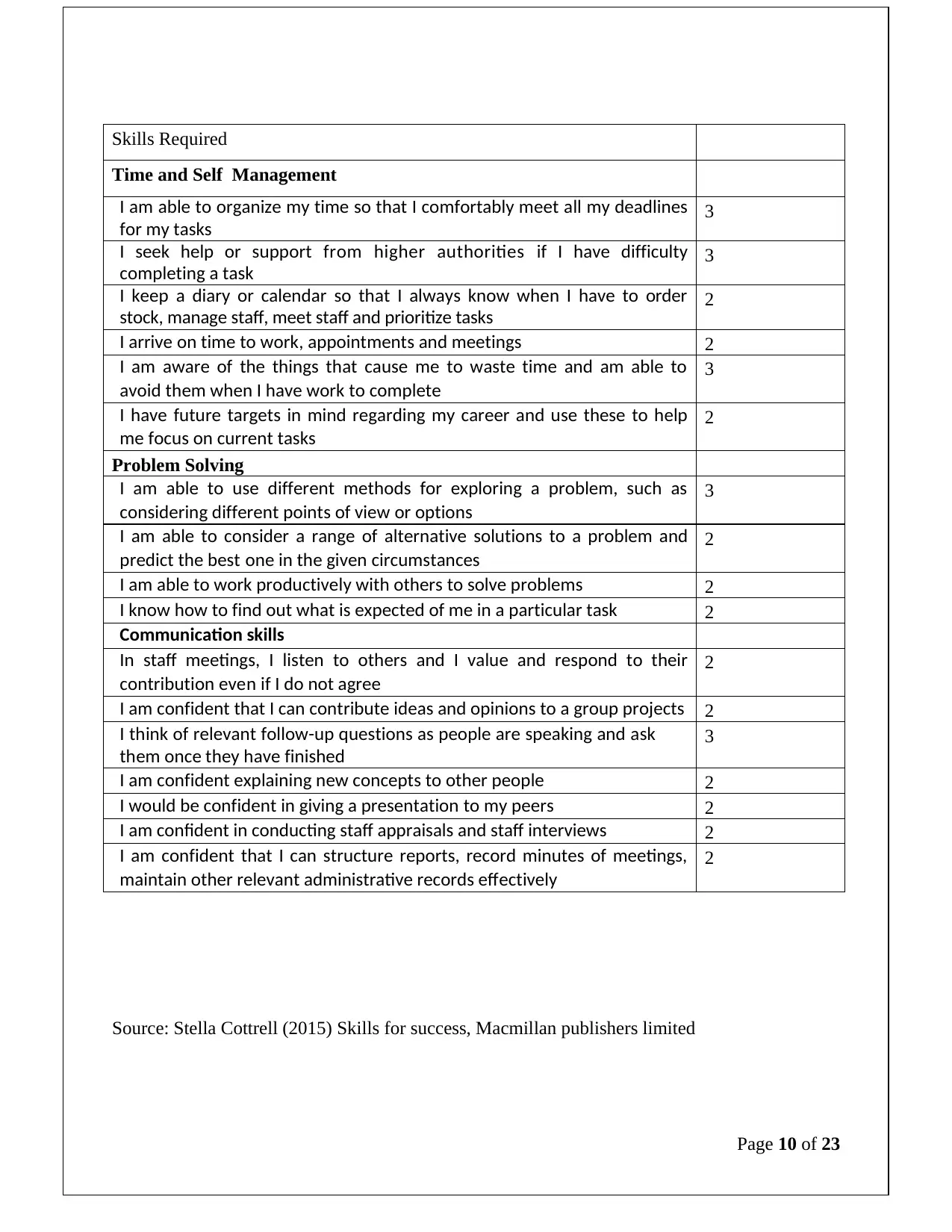
Source: Stella Cottrell (2015) Skills for success, Macmillan publishers limited
Page 10 of 23
Skills Required
Time and Self Management
I am able to organize my time so that I comfortably meet all my deadlines
for my tasks 3
I seek help or support from higher authorities if I have difficulty
completing a task 3
I keep a diary or calendar so that I always know when I have to order
stock, manage staff, meet staff and prioritize tasks 2
I arrive on time to work, appointments and meetings 2
I am aware of the things that cause me to waste time and am able to
avoid them when I have work to complete
3
I have future targets in mind regarding my career and use these to help
me focus on current tasks
2
Problem Solving
I am able to use different methods for exploring a problem, such as
considering different points of view or options
3
I am able to consider a range of alternative solutions to a problem and
predict the best one in the given circumstances
2
I am able to work productively with others to solve problems 2
I know how to find out what is expected of me in a particular task 2
Communication skills
In staff meetings, I listen to others and I value and respond to their
contribution even if I do not agree
2
I am confident that I can contribute ideas and opinions to a group projects 2
I think of relevant follow-up questions as people are speaking and ask
them once they have finished
3
I am confident explaining new concepts to other people 2
I would be confident in giving a presentation to my peers 2
I am confident in conducting staff appraisals and staff interviews 2
I am confident that I can structure reports, record minutes of meetings,
maintain other relevant administrative records effectively
2
Page 10 of 23
Skills Required
Time and Self Management
I am able to organize my time so that I comfortably meet all my deadlines
for my tasks 3
I seek help or support from higher authorities if I have difficulty
completing a task 3
I keep a diary or calendar so that I always know when I have to order
stock, manage staff, meet staff and prioritize tasks 2
I arrive on time to work, appointments and meetings 2
I am aware of the things that cause me to waste time and am able to
avoid them when I have work to complete
3
I have future targets in mind regarding my career and use these to help
me focus on current tasks
2
Problem Solving
I am able to use different methods for exploring a problem, such as
considering different points of view or options
3
I am able to consider a range of alternative solutions to a problem and
predict the best one in the given circumstances
2
I am able to work productively with others to solve problems 2
I know how to find out what is expected of me in a particular task 2
Communication skills
In staff meetings, I listen to others and I value and respond to their
contribution even if I do not agree
2
I am confident that I can contribute ideas and opinions to a group projects 2
I think of relevant follow-up questions as people are speaking and ask
them once they have finished
3
I am confident explaining new concepts to other people 2
I would be confident in giving a presentation to my peers 2
I am confident in conducting staff appraisals and staff interviews 2
I am confident that I can structure reports, record minutes of meetings,
maintain other relevant administrative records effectively
2
Paraphrase This Document
Need a fresh take? Get an instant paraphrase of this document with our AI Paraphraser
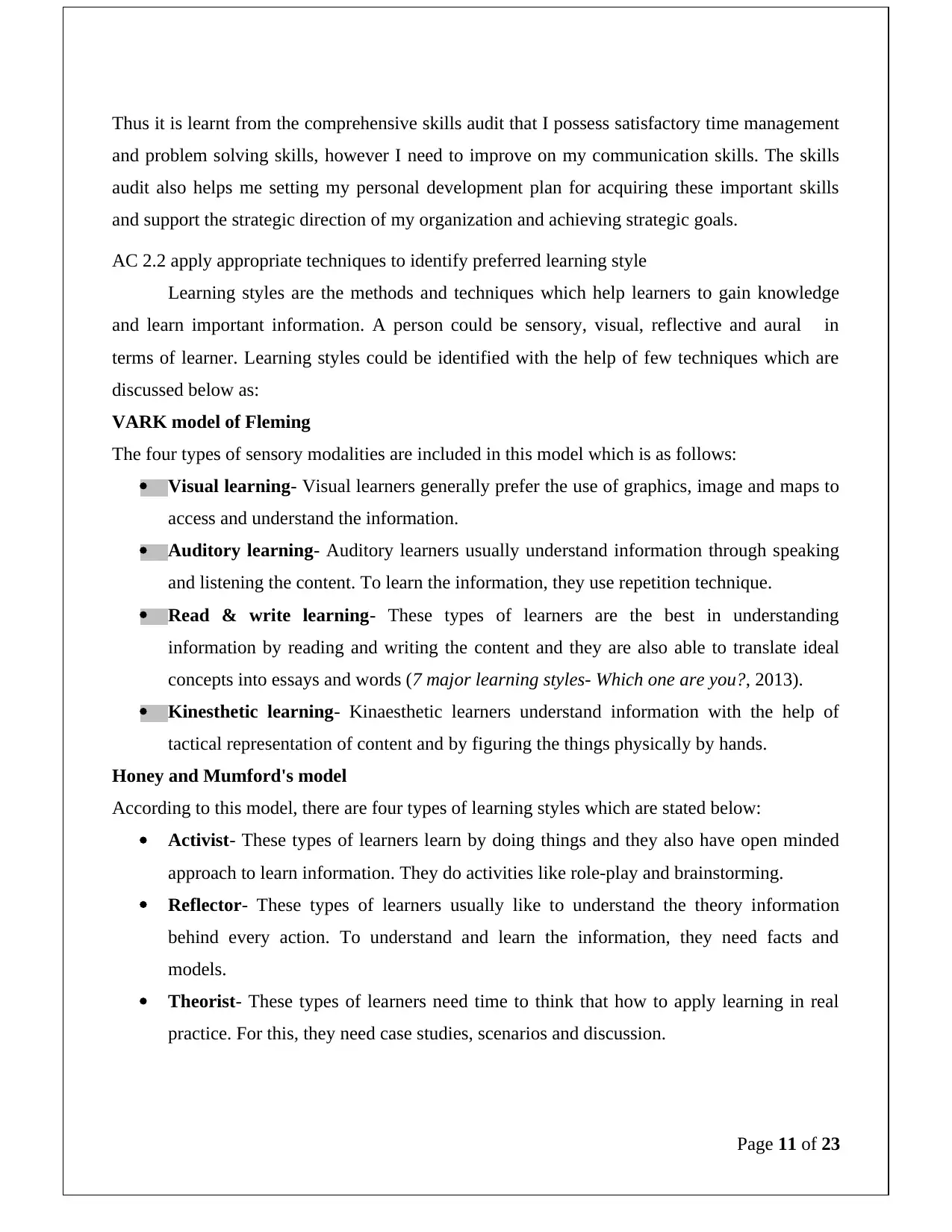
Thus it is learnt from the comprehensive skills audit that I possess satisfactory time management
and problem solving skills, however I need to improve on my communication skills. The skills
audit also helps me setting my personal development plan for acquiring these important skills
and support the strategic direction of my organization and achieving strategic goals.
AC 2.2 apply appropriate techniques to identify preferred learning style
Learning styles are the methods and techniques which help learners to gain knowledge
and learn important information. A person could be sensory, visual, reflective and aural in
terms of learner. Learning styles could be identified with the help of few techniques which are
discussed below as:
VARK model of Fleming
The four types of sensory modalities are included in this model which is as follows:
Visual learning- Visual learners generally prefer the use of graphics, image and maps to
access and understand the information.
Auditory learning- Auditory learners usually understand information through speaking
and listening the content. To learn the information, they use repetition technique.
Read & write learning- These types of learners are the best in understanding
information by reading and writing the content and they are also able to translate ideal
concepts into essays and words (7 major learning styles- Which one are you?, 2013).
Kinesthetic learning- Kinaesthetic learners understand information with the help of
tactical representation of content and by figuring the things physically by hands.
Honey and Mumford's model
According to this model, there are four types of learning styles which are stated below:
Activist- These types of learners learn by doing things and they also have open minded
approach to learn information. They do activities like role-play and brainstorming.
Reflector- These types of learners usually like to understand the theory information
behind every action. To understand and learn the information, they need facts and
models.
Theorist- These types of learners need time to think that how to apply learning in real
practice. For this, they need case studies, scenarios and discussion.
Page 11 of 23
and problem solving skills, however I need to improve on my communication skills. The skills
audit also helps me setting my personal development plan for acquiring these important skills
and support the strategic direction of my organization and achieving strategic goals.
AC 2.2 apply appropriate techniques to identify preferred learning style
Learning styles are the methods and techniques which help learners to gain knowledge
and learn important information. A person could be sensory, visual, reflective and aural in
terms of learner. Learning styles could be identified with the help of few techniques which are
discussed below as:
VARK model of Fleming
The four types of sensory modalities are included in this model which is as follows:
Visual learning- Visual learners generally prefer the use of graphics, image and maps to
access and understand the information.
Auditory learning- Auditory learners usually understand information through speaking
and listening the content. To learn the information, they use repetition technique.
Read & write learning- These types of learners are the best in understanding
information by reading and writing the content and they are also able to translate ideal
concepts into essays and words (7 major learning styles- Which one are you?, 2013).
Kinesthetic learning- Kinaesthetic learners understand information with the help of
tactical representation of content and by figuring the things physically by hands.
Honey and Mumford's model
According to this model, there are four types of learning styles which are stated below:
Activist- These types of learners learn by doing things and they also have open minded
approach to learn information. They do activities like role-play and brainstorming.
Reflector- These types of learners usually like to understand the theory information
behind every action. To understand and learn the information, they need facts and
models.
Theorist- These types of learners need time to think that how to apply learning in real
practice. For this, they need case studies, scenarios and discussion.
Page 11 of 23
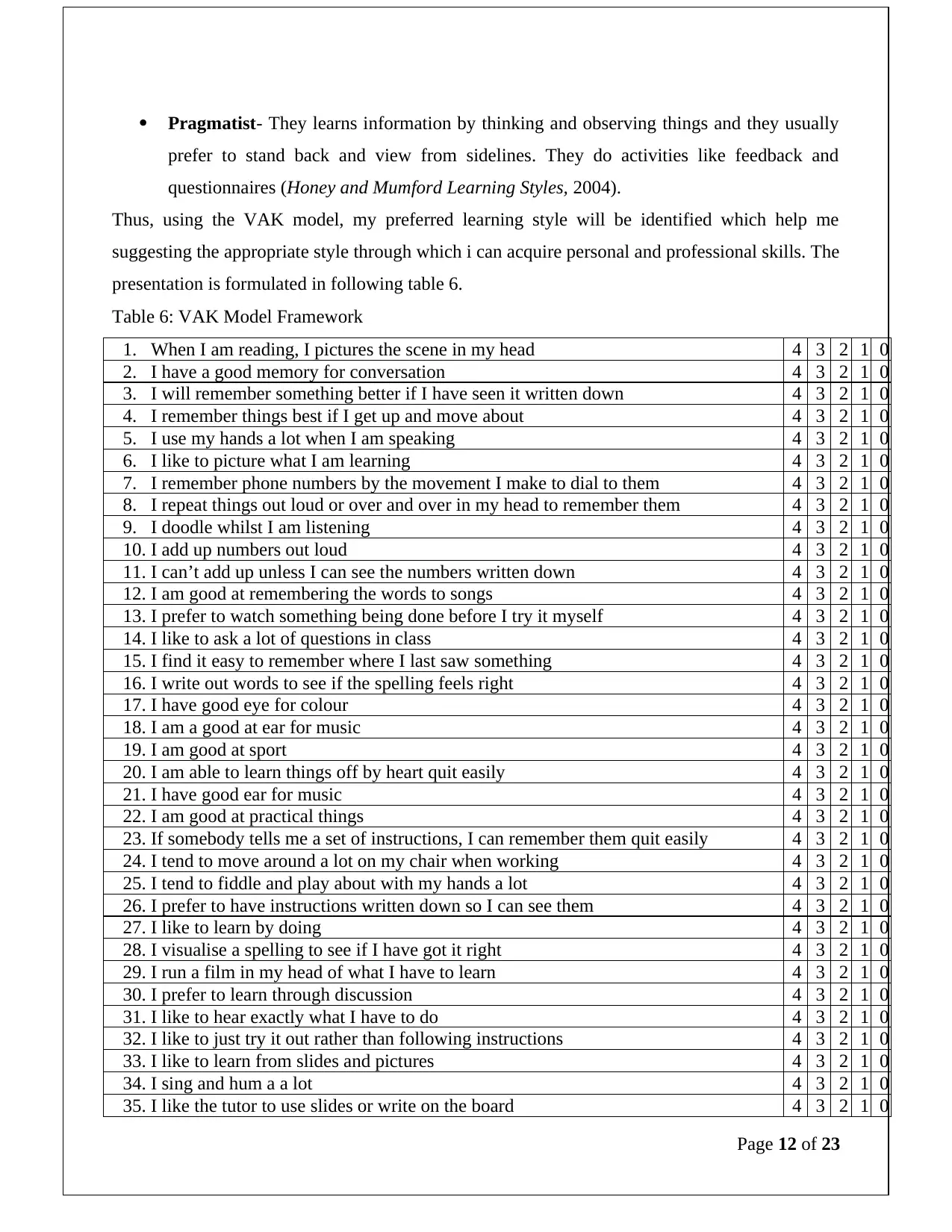
Pragmatist- They learns information by thinking and observing things and they usually
prefer to stand back and view from sidelines. They do activities like feedback and
questionnaires (Honey and Mumford Learning Styles, 2004).
Thus, using the VAK model, my preferred learning style will be identified which help me
suggesting the appropriate style through which i can acquire personal and professional skills. The
presentation is formulated in following table 6.
Table 6: VAK Model Framework
1. When I am reading, I pictures the scene in my head 4 3 2 1 0
2. I have a good memory for conversation 4 3 2 1 0
3. I will remember something better if I have seen it written down 4 3 2 1 0
4. I remember things best if I get up and move about 4 3 2 1 0
5. I use my hands a lot when I am speaking 4 3 2 1 0
6. I like to picture what I am learning 4 3 2 1 0
7. I remember phone numbers by the movement I make to dial to them 4 3 2 1 0
8. I repeat things out loud or over and over in my head to remember them 4 3 2 1 0
9. I doodle whilst I am listening 4 3 2 1 0
10. I add up numbers out loud 4 3 2 1 0
11. I can’t add up unless I can see the numbers written down 4 3 2 1 0
12. I am good at remembering the words to songs 4 3 2 1 0
13. I prefer to watch something being done before I try it myself 4 3 2 1 0
14. I like to ask a lot of questions in class 4 3 2 1 0
15. I find it easy to remember where I last saw something 4 3 2 1 0
16. I write out words to see if the spelling feels right 4 3 2 1 0
17. I have good eye for colour 4 3 2 1 0
18. I am a good at ear for music 4 3 2 1 0
19. I am good at sport 4 3 2 1 0
20. I am able to learn things off by heart quit easily 4 3 2 1 0
21. I have good ear for music 4 3 2 1 0
22. I am good at practical things 4 3 2 1 0
23. If somebody tells me a set of instructions, I can remember them quit easily 4 3 2 1 0
24. I tend to move around a lot on my chair when working 4 3 2 1 0
25. I tend to fiddle and play about with my hands a lot 4 3 2 1 0
26. I prefer to have instructions written down so I can see them 4 3 2 1 0
27. I like to learn by doing 4 3 2 1 0
28. I visualise a spelling to see if I have got it right 4 3 2 1 0
29. I run a film in my head of what I have to learn 4 3 2 1 0
30. I prefer to learn through discussion 4 3 2 1 0
31. I like to hear exactly what I have to do 4 3 2 1 0
32. I like to just try it out rather than following instructions 4 3 2 1 0
33. I like to learn from slides and pictures 4 3 2 1 0
34. I sing and hum a a lot 4 3 2 1 0
35. I like the tutor to use slides or write on the board 4 3 2 1 0
Page 12 of 23
prefer to stand back and view from sidelines. They do activities like feedback and
questionnaires (Honey and Mumford Learning Styles, 2004).
Thus, using the VAK model, my preferred learning style will be identified which help me
suggesting the appropriate style through which i can acquire personal and professional skills. The
presentation is formulated in following table 6.
Table 6: VAK Model Framework
1. When I am reading, I pictures the scene in my head 4 3 2 1 0
2. I have a good memory for conversation 4 3 2 1 0
3. I will remember something better if I have seen it written down 4 3 2 1 0
4. I remember things best if I get up and move about 4 3 2 1 0
5. I use my hands a lot when I am speaking 4 3 2 1 0
6. I like to picture what I am learning 4 3 2 1 0
7. I remember phone numbers by the movement I make to dial to them 4 3 2 1 0
8. I repeat things out loud or over and over in my head to remember them 4 3 2 1 0
9. I doodle whilst I am listening 4 3 2 1 0
10. I add up numbers out loud 4 3 2 1 0
11. I can’t add up unless I can see the numbers written down 4 3 2 1 0
12. I am good at remembering the words to songs 4 3 2 1 0
13. I prefer to watch something being done before I try it myself 4 3 2 1 0
14. I like to ask a lot of questions in class 4 3 2 1 0
15. I find it easy to remember where I last saw something 4 3 2 1 0
16. I write out words to see if the spelling feels right 4 3 2 1 0
17. I have good eye for colour 4 3 2 1 0
18. I am a good at ear for music 4 3 2 1 0
19. I am good at sport 4 3 2 1 0
20. I am able to learn things off by heart quit easily 4 3 2 1 0
21. I have good ear for music 4 3 2 1 0
22. I am good at practical things 4 3 2 1 0
23. If somebody tells me a set of instructions, I can remember them quit easily 4 3 2 1 0
24. I tend to move around a lot on my chair when working 4 3 2 1 0
25. I tend to fiddle and play about with my hands a lot 4 3 2 1 0
26. I prefer to have instructions written down so I can see them 4 3 2 1 0
27. I like to learn by doing 4 3 2 1 0
28. I visualise a spelling to see if I have got it right 4 3 2 1 0
29. I run a film in my head of what I have to learn 4 3 2 1 0
30. I prefer to learn through discussion 4 3 2 1 0
31. I like to hear exactly what I have to do 4 3 2 1 0
32. I like to just try it out rather than following instructions 4 3 2 1 0
33. I like to learn from slides and pictures 4 3 2 1 0
34. I sing and hum a a lot 4 3 2 1 0
35. I like the tutor to use slides or write on the board 4 3 2 1 0
Page 12 of 23
⊘ This is a preview!⊘
Do you want full access?
Subscribe today to unlock all pages.

Trusted by 1+ million students worldwide
1 out of 22
Related Documents
Your All-in-One AI-Powered Toolkit for Academic Success.
+13062052269
info@desklib.com
Available 24*7 on WhatsApp / Email
![[object Object]](/_next/static/media/star-bottom.7253800d.svg)
Unlock your academic potential
Copyright © 2020–2025 A2Z Services. All Rights Reserved. Developed and managed by ZUCOL.





